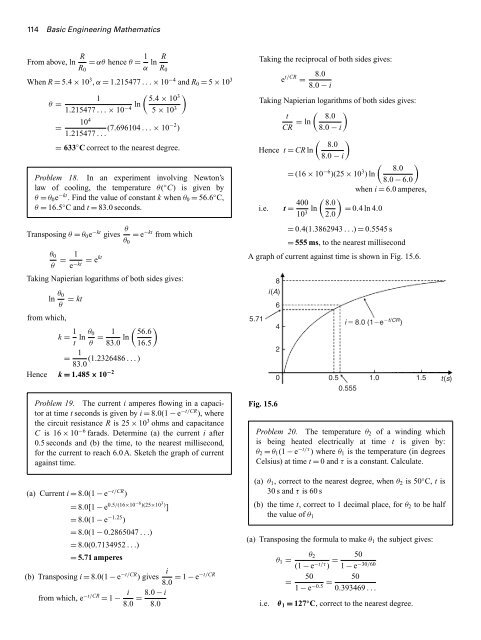basic_engineering_mathematics0
Create successful ePaper yourself
Turn your PDF publications into a flip-book with our unique Google optimized e-Paper software.
114 Basic Engineering Mathematics<br />
From above, ln R R 0<br />
= αθ hence θ = 1 α ln R R 0<br />
When R = 5.4 × 10 3 , α = 1.215477 ...× 10 −4 and R 0 = 5 × 10 3<br />
θ =<br />
=<br />
(<br />
1<br />
5.4 × 10<br />
3<br />
)<br />
1.215477 ...× 10 ln −4 5 × 10 3<br />
10 4<br />
1.215477 ... (7.696104 ...× 10−2 )<br />
= 633 ◦ C correct to the nearest degree.<br />
Problem 18. In an experiment involving Newton’s<br />
law of cooling, the temperature θ( ◦ C) is given by<br />
θ = θ 0 e −kt . Find the value of constant k when θ 0 = 56.6 ◦ C,<br />
θ = 16.5 ◦ C and t = 83.0 seconds.<br />
Transposing θ = θ 0 e −kt gives θ θ 0<br />
= e −kt from which<br />
θ 0<br />
θ = 1 = e kt<br />
e −kt<br />
Taking Napierian logarithms of both sides gives:<br />
ln θ 0<br />
θ = kt<br />
from which,<br />
k = 1 t ln θ 0<br />
θ = 1 ( ) 56.6<br />
83.0 ln 16.5<br />
= 1 (1.2326486 ...)<br />
83.0<br />
Hence k = 1.485 × 10 −2<br />
Problem 19. The current i amperes flowing in a capacitor<br />
at time t seconds is given by i = 8.0(1 − e −t/CR ), where<br />
the circuit resistance R is 25 × 10 3 ohms and capacitance<br />
C is 16 × 10 −6 farads. Determine (a) the current i after<br />
0.5 seconds and (b) the time, to the nearest millisecond,<br />
for the current to reach 6.0A. Sketch the graph of current<br />
against time.<br />
(a) Current i = 8.0(1 − e −t/CR )<br />
= 8.0[1 − e 0.5/(16×10−6 )(25×10 3) ]<br />
= 8.0(1 − e −1.25 )<br />
= 8.0(1 − 0.2865047 ...)<br />
= 8.0(0.7134952 ...)<br />
= 5.71 amperes<br />
(b) Transposing i = 8.0(1 − e −t/CR i<br />
)gives<br />
8.0 = 1 − e−t/CR<br />
from which, e −t/CR = 1 −<br />
i<br />
8.0 = 8.0 − i<br />
8.0<br />
Taking the reciprocal of both sides gives:<br />
e t/CR = 8.0<br />
8.0 − i<br />
Taking Napierian logarithms of both sides gives:<br />
( )<br />
t 8.0<br />
CR = ln 8.0 − i<br />
( ) 8.0<br />
Hence t = CR ln<br />
8.0 − i<br />
( ) 8.0<br />
= (16 × 10 −6 )(25 × 10 3 )ln<br />
8.0 − 6.0<br />
when i = 6.0 amperes,<br />
i.e. t = 400 ( ) 8.0<br />
10 ln = 0.4ln4.0<br />
3 2.0<br />
= 0.4(1.3862943 ...) = 0.5545 s<br />
= 555 ms, to the nearest millisecond<br />
A graph of current against time is shown in Fig. 15.6.<br />
5.71<br />
8<br />
i(A)<br />
Fig. 15.6<br />
6<br />
4<br />
2<br />
i 8.0 (1e t/CR )<br />
0 0.5 1.0 1.5 t(s)<br />
0.555<br />
Problem 20. The temperature θ 2 of a winding which<br />
is being heated electrically at time t is given by:<br />
θ 2 = θ 1 (1 − e −t/τ ) where θ 1 is the temperature (in degrees<br />
Celsius) at time t = 0 and τ is a constant. Calculate.<br />
(a) θ 1 , correct to the nearest degree, when θ 2 is 50 ◦ C, t is<br />
30 s and τ is 60 s<br />
(b) the time t, correct to 1 decimal place, for θ 2 to be half<br />
the value of θ 1<br />
(a) Transposing the formula to make θ 1 the subject gives:<br />
i.e.<br />
θ 2<br />
θ 1 =<br />
(1 − e −t/τ ) = 50<br />
1 − e −30/60<br />
50<br />
=<br />
1 − e = 50<br />
−0.5 0.393469 ...<br />
θ 1 = 127 ◦ C, correct to the nearest degree.















![[Lonely Planet] Sri Lanka](https://img.yumpu.com/59845622/1/169x260/lonely-planet-sri-lanka.jpg?quality=85)

